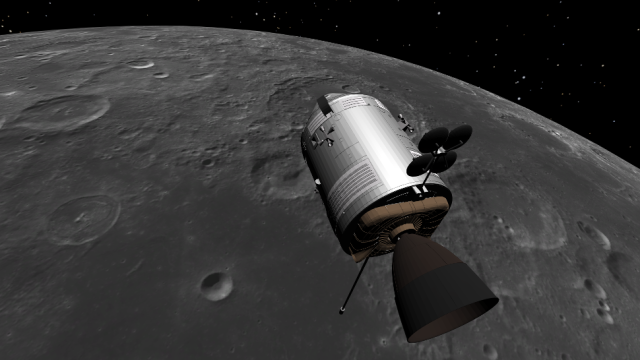Scientists at the European Space Agency are using a powerful new simulator to relive the Apollo 15 mission in excruciating detail. By revisiting this and other missions, the researchers are seeing old data with new eyes, and the exercise will also help in the planning of future missions.
Developed by NASA’s Jet Propulsion Laboratory, the system is called SPICE, and it’s allowing researchers with the European Space Agency to recreate historic missions in high-definition, 360-degree virtual reality, according to an ESA press release.
This is an amazing and informative exercise in its own right, but SPICE is also offering new ways of demonstrating and validating archival scientific data. At the same time, it’s providing a new platform for testing systems that are expected to be used during upcoming lunar missions.
The SPICE platform being used by the ESA is stationed at its ESAC astronomy centre in Spain. This software can interpret and process data collected from previous missions, such as the 1971 Apollo 15 mission to the Moon, which was well-equipped with scientific instrumentation. This old data finding new life.
This has allowed the team, for example, to simulate the view of the lunar surface as seen from the Apollo 15 Command Service Module (CSM) as it orbited the Moon.
“By combining positioning data with a highly detailed digital elevation model of the lunar surface, we can know exactly what the instruments were pointing at as they [recorded] their results,” explained ESA project scientist Erik Kuulkers in the press release.
To collect information like the orbiter’s altitude, orientation, and velocity, the researchers pulled information from the CMS’s Gamma Ray Spectrometer and X-Ray Fluorescence Spectrometer. Data collected by these tools wasn’t meant for this (they were being used to measure the composition of the Moon’s surface, among other things), but this data is now being leveraged in a very cool way.
“These two instruments were mounted together in the Scientific Instrument Module (SIM) of CSM,” said ESA SPICE Service engineer Alfredo Escalante López. “To check the accuracy of our recreation we went on to compare images gathered by the visible-light Mapping Camera, also in the SIM with our artificially generated views.”
Using topographical data collected by modern instruments, such as the laser altimeter on NASA’s Lunar Reconnaissance Orbiter, the scientists were able to achieve resolutions of 5 metres per pixel.
In addition to the overhead lunar flyby, the researchers have simulated and subsequently studied the landing of the Apollo 15 Lunar Module and a drive around the landing site aboard the Lunar Rover. The scientists have also simulated the ESA’s 2003 SMART-1 mission, which tested solar electric propulsion and made observations of the lunar surface.
Future applications of SPICE will allow various ESA teams to prepare for future missions, such as Mars Express, Venus Express, Rosetta, the ExoMars Trace Gas Orbiter, BepiColombo (Mercury), and Russia’s Luna-27, which is scheduled to explore the lunar surface looking for water ice and other minerals as early as 2025. By simulating future missions to the Moon, the researchers can develop and test systems capable of avoiding perilous terrain, among other tricky mission requirements.
Another cool aspect about SPICE is that the ESA is making all of this data available to the public. So if you’ve got virtual reality headset, buckle up and relive some of the most iconic moments in space history.
